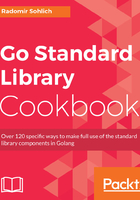
What this book covers
Chapter 1, Interacting with the Environment, explores how your code can interact with the operating system environment. The use of command-line flags and arguments, consuming signals, and working with child processes are also covered.
Chapter 2, Strings and Things, goes through common operations on strings, from simple searching for substrings to formatting text to tabs.
Chapter 3, Dealing with Numbers, sheds light on basic conversions and number formatting options. Operations with large numbers and the correct use of plurals within output messages are covered.
Chapter 4, Once Upon a Time, puts the time package under the magnifying glass and covers formatting, arithmetics, and running code for given time period or after a certain delay.
Chapter 5, In and Out, covers I/O operations that utilize standard Go interfaces. Besides the basic I/O, the chapter also covers some useful serialization formats and how to handle them.
Chapter 6, Discover the Filesystem, discusses working with the filesystem, including listing the folders, reading and changing the file attributes, and comparing files side by side.
Chapter 7, Connect the Network, showcases the client-side implementations for connecting the TCP and UDP server, along with the use of SMTP, HTTP, and JSON-RPC .
Chapter 8, Working with Databases, focuses on common database tasks such as data selection and extraction, transaction handling and execution, and the shortcomings of stored procedures.
Chapter 9, Come to the Server Side, provides a view on networking from the server's perspective. TCP, UDP, and HTTP server basics are presented.
Chapter 10, Fun with Concurrency, deals with mechanisms of synchronization and concurrent access to resources.
Chapter 11, Tips and Tricks, comes with useful tips for testing and improving the HTTP server implementation and shows the benefits of HTTP/2 push.